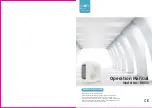
Page 12
1− Attach gauge manifold and connect vacuum pump
(with vacuum gauge) to center port of gauge man
ifold. With both gauge manifold service valves open,
start pump and evacuate evaporator and refrigerant
lines.
IMPORTANT
A temperature vacuum gauge, mercury vacuum
(U−tube), or thermocouple gauge should be used.
The usual Bourdon tube gauges are not accurate
enough in the vacuum range.
IMPORTANT
The compressor should never be used to evacu
ate a refrigeration or air conditioning system.
CAUTION
Danger of Equipment Damage. Avoid deep vacuum
operation. Do not use compressors to evacuate a
system. Extremely low vacuums can cause internal
arcing and compressor failure. Damage caused by
deep vacuum operation will void warranty.
2− Evacuate the system to an
absolute
pressure of
.92 inches of mercury, 23 mm of mercury, or 23,000
microns.
3− After system has been evacuated to an absolute
pressure of .92 inches of mercury, 23 mm of mercury,
or 23,000 microns, close manifold valve to center
port.
4− Stop vacuum pump and disconnect from gauge man
ifold. Attach a drum of dry nitrogen to center port of
gauge manifold, open drum valve slightly to purge line,
then break vacuum in system to 3 psig (20.7 kPa) pres
sure by opening manifold high pressure valve to center
port.
5− Close nitrogen drum valve, disconnect drum from
manifold center port and release nitrogen pressure
from system.
6− Reconnect vacuum pump to manifold center port
hose. Evacuate the system to an absolute pressure
less than .197 inches of mercury, 5 mm of mercury, or
5000 microns, then turn off vacuum pump. If the abso
lute pressure rises above .197 inches of mercury, 5
mm of mercury, or 5000 microns within a 20−minute
period after stopping vacuum pump, repeat step 6. If
not, evacuation is complete.
This evacuation procedure is adequate for a new
installation with clean and dry lines. If excessive mois
ture is present, the evacuation process may be re
quired more than once.
7− After evacuation has been completed, close gauge
manifold service valves. Disconnect vacuum pump
from manifold center port and connect refrigerant
drum. Pressurize system slightly with refrigerant to
break vacuum.
IMPORTANT
Use tables 9 and 10 as a general guide for perform
ing maintenance checks. Table 9 is not a procedure
for charging the system. Minor variations in these
pressures may be expected due to differences in
installations. Significant deviations could mean that
the system is not properly charged or that a problem
exists with some component in the system. Used
prudently, tables 9 and 10 could serve as a useful
service guide.
C−Charging
TABLE 9 (Early Models)
NORMAL OPERATING PRESSURES
OUTDOOR
TEMP. (
_
F)
HS26−261
HS26−311
HS26−411
65
75
85
95
LIQ.
+ 10
SUC.
+ 10
PSIG
PSIG
LIQ.
+ 10
SUC.
+ 10
PSIG
PSIG
LIQ.
+ 10
SUC.
+ 10
PSIG
PSIG
105
LIQ.
+ 10
SUC.
+ 10
PSIG
PSIG
HS26−461
141
163
191
220
255
77
79
80
82
83
140
160
186
216
254
69
74
78
80
81
141
167
195
225
260
75
77
79
80
81
140
170
170
223
261
62
77
77
80
81




































